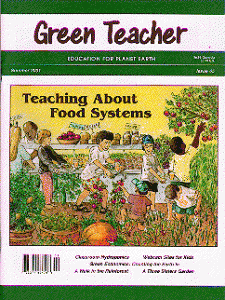Green Teacher 65, Summer 2001
 Features
Features
Teaching About Food Systems by Carmela Federico
The food on our table is a product of an intricate web of natural factors and human actors. This article looks at a number of food systems projects that promote students’ understanding of the biological, cultural and economic dimensions of how food is produced and distributed. Includes “Tips for Success with School Food Gardens”, and a list of recommended North American resources and organizations for food systems education.
What is a Sustainable Food System? (activity)
Adapted by the Sustainability Education Center from a lesson in “Is Hunger a Global Problem?”, a unit developed at theCenter for A Sustainable Future in Shelburne, Vermont. This is a middle school activity through which students consider the sustainability of the various components of our multifaceted system of food production and distribution.
Tools of Hope Game (activity)
Adapted by The Sustainability Education Center in New York City from We Can Do That: Tool Hunger Education Activities That Work by Church World Service. In this board game for middle and high school students, players learn about the causes of hunger in developing countries and the relationship between hunger and sustainable development. Includes Tools of Hope cards, and playing board.
A Three Sisters Garden
Teaching activities and a how-to planting lesson that introduces students to the “Three Sisters.”
Classroom Hydroponics by Douglas J. Peckenpaugh
A general introduction to hydroponic growing systems, step-by-step instructions on how to construct and maintain a hydroponic system in your school, and short case studies of school projects.
A Walk in the Rain Forest by Glenn Gustafson
Creating and leading a multisensory rain forest “tour” in your classroom, school gym or community centre is a great way to introduce students to the global importance of rain forests. Includes selected resources for rain forest studies.
Green Economics: Counting Earth In by Ken Shears
This article exposes the myth that economics can be separated from the natural capital upon which all of our getting and spending depends. The author includes examples of how teachers can incorporate green economics in their curriculum.
Eco-economics in the Classroom by Susan Santone
Ecological economics offers teachers and students opportunities to explore such vital and timely topics as consumption, population, climate change and development.
Eco-Economics: A Manufacturing Challenge
Adapted from The Shape of Change: A Curriculum for Building Strong Communities and a Sustainable Economy. In this hands-on simulation, students must produce placemats with as little waste and pollution as possible – an environmental challenge faced by many manufacturers.
Inside the Internet: Smile…You’re on Webcam! by Katharine Isbell
And as always, over 20 new educational resources are profiled and evaluated in this issue of Green Teacher.
Leave a Reply
You must be logged in to post a comment.





